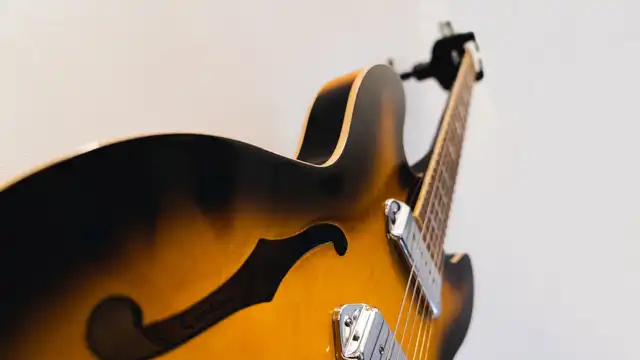Bolt On vs Set Neck vs Neck Thru


The bolt on vs set neck vs neck thru discussion can be one of the more passionate ones in the guitar community. Many players have strong opinions about which they prefer, and many players enjoy them all. Despite all that, each neck type has merit and can be seen on stages all over the world. Today, we’re going to cut through all the chatter and talk about how these necks came about, what guitars use them, and what advantages/disadvantages they have.
Read on below, or check out our video comparing the three major guitar neck types to see each of them in action!
Bolt Ons
First, let’s start with bolt on necks. The name is pretty self-explanatory; bolt on necks are bolted onto the guitar’s body. They have been around for decades and are still one of the most popular neck types out there, so let’s see how they came about, what guitars have them, and why or why not you might want to use one.

History and Use
Bolt on necks were first popularized in the 50s by none other than Leo Fender, with the original Telecaster being the first prominent bolt on neck guitar. Fender opted for this method because it allowed for guitars to be made faster and cheaper while still maintaining consistent quality. They also allowed for easier repairs since you can easily take the neck off and replace it.
Since being innovated in the 50s, bolt on necks have become the standard for most Stratocaster and Telecaster type guitars. Many view bolt on guitars as cheap since most lower end guitars are bolt on, but that association isn’t necessarily true. Nearly all of Fender’s guitars are still made with bolt-on necks, including their higher end offerings. There are other high end bolt on guitars made by companies like G&L as well. Though many cheap guitars use bolt on necks to cut costs, a bolt on neck doesn’t necessarily mean a guitar is low quality.
Advantages
So what advantages do bolt necks have? Why use them in the first place? Well, there are plenty of reasons why bolt on necks are still so popular.
One of the main advantages of bolt on necks is cost. It is cheaper to make a guitar with a bolt on neck, which means it’s cheaper for manufacturers and consumers. If you’re looking for a guitar on a tight budget, bolt on neck guitars like a Squire or MIM Fender can be a great option.
Another advantage, as Leo Fender figured out, is that they’re much easier to repair and modify. If you break the headstock or neck of a set neck or neck thru guitar, it is usually a more involved and expensive repair. But with a bolt on, you simply have to remove the bolts and bolt on the new neck. That also makes modifications easy since you can quickly and easily swap out the neck.
Lastly, many players prefer the tone and feel of bolt on guitars. They tend to have a more twangy and snappy tone, which can be great depending on the sound you want. Bolt on neck guitars like the Telecaster are very popular in genres like country partially because of the snappy and twangy nature of bolt on necks.
Disadvantages
Though tone was an advantage, it can also be a disadvantage if you don’t like a snappy and twangy tone. Many players simply prefer a warmer and thicker tone, so they prefer set neck or neck thru guitars. That said, bolt on guitars can still be found in genres where you wouldn’t expect them, like metal.
Another disadvantage is the perceived cheapness. A lot of players view bolt on guitars as cheaper and lesser, whether or not they actually are. Even though that isn’t necessarily true, it can still be a disadvantage if you believe that bolt ons are for lesser quality guitars.
Lastly, many players believe that the bolt on construction causes a loss of tone. This is one of the more subjective and debated topics like tone wood, but it’s a big point of discussion nonetheless. If you are a tonal purist, you may end up opting for a set neck or neck thru guitar.

Set Necks
Now, let's move to set necks. Set necks have been around even longer than bolt on necks, and they are also still incredibly popular. As the name suggests, they are “set” into the body, typically glued in place to make a tightly fitted neck joint. Time to see why set necks have stood the test of time and are one of the most common neck types.
History and Use
Set necks are the oldest method of neck construction listed here by far. Set necks have been in use for hundreds of years on all manner of stringed instruments like violins, classical guitars, cellos, and more. It makes sense that this is the “traditional” form of neck construction given that it only requires precise woodworking and glue.
However, set necks became directly associated with Gibson during the 50s and 60s. Fender was known for bolt ons, and Gibson was known for set necks. They were the two most popular guitar companies by far, so they each became associated with their neck types. Though Gibson also makes many neck thru guitars, they are still most associated with set necks.
Gibson isn’t the only company to make neck thru guitars though. Plenty of other modern companies such as PRS still use set necks, not to mention that nearly all acoustic guitars are still made with set necks.
Advantages
The main advantages of neck thru guitars are tone and feel. With a neck thru guitar, there is better tonal transfer between the neck and body. This leads to a fuller, warmer tone. Many players really like the sound of neck thru guitars and just prefer them to bolt ons. Also, this improved tonal transfer can increase sustain, another big plus for set neck guitars.
Disadvantages
The main disadvantages of neck thru guitars are cost and repair. In general, neck thru guitars tend to be a bit more expensive than bolt on guitars. While that isn’t a huge deal to everyone, it can be if you’re on a budget. Repairs are a bigger issue however. Neck thru guitars are almost impossible to perfectly reset, and they are very hard to repair besides. Again, this may not be an issue if you have the money to pay for repairs or a new guitar, but it’s something worth considering when making a purchase.
One smaller disadvantage to consider is that, while set neck guitars have more sustain and better tonal transfer than bolt on necks, they still have less sustain and tonal transfer than neck thru guitars. They are a bit of a middle ground between bolt on and neck thru necks.

Neck Thru
Finally, let’s talk about neck thru guitars. These are guitars where the neck is the same piece of wood as the middle of the body. The neck goes all the way through the guitar, hence the name. Typically, the neck and center of the body are a single piece of wood, with “wings” added on to make the rest of the body. These necks are increasingly popular, so let’s see what all the fuss is about.
History and Use
Though many associate neck thru guitars with the higher end guitars of today, neck thru guitars actually predate bolt on guitars. Rickenbacker started using a neck thru design on some models as early as the 1930s, though it became more prominent in the 50s. Gibson and others were also playing around with neck thru designs in the 40s and 50s.
Since then, neck thru guitars have become very popular. Companies like Ibanez, Yamaha, BC Rich, Carvin, ESP, Schecter, Alembic, and more sell a ton of neck thru guitars. Rickenbacker still makes many neck thru guitars, and Gibson still uses the technique for their Firebird and Thunderbird models.
Advantages
There are a couple of big advantages of neck thru guitars. The first is that they tend to be more durable and resilient. Because of their construction, they are more stable than other guitars. They are less likely to bend and warp over time. Many shredders and metal players prefer them because the stability makes keeping very low action easier.
The other big advantage is that, as mentioned before, neck thru guitars provide the most sustain and tonal transfer. Because the neck and body are a solid piece of wood, all of the energy will transfer between the neck and body. This leads to more sustain and better tone, though better is subjective since many prefer the tone from bolt on or set neck guitars.
Disadvantages
While you may think neck thrus would have no disadvantages, that isn’t the case. One con is that they tend to be more expensive than the other options. Because they require more effort and time to make, they are typically more costly. That might only be a minor issue for you depending on your finances, but it is one worth noting.
Another downside is that repairs are difficult and costly. You can’t just swap out the neck like with a bolt on, so it can make certain repairs near impossible or incredibly expensive. If you baby your guitars and don’t gig with them that may not be a concern, but it could be a deal breaker if you’re someone who puts your guitar through a lot of abuse.
Conclusion
The debate between bolt on, set necks, and neck thru guitars isn’t going to end any time soon. Each type of neck construction has its pros and cons, and none of them are any better or worse than any other. As with most guitar related topics, it ultimately comes down to your personal preference and tastes. Do your research, try out some guitars, and figure out what makes sense for you.
Other Posts you may like

Guitar Strings Order: How the Guitar is Tuned and Why

Best Acoustic Guitar Strings for Beginners

Two Handed Tapping: Our Top 8 Tappers of All Time

Which Guitar Strings Wear Your Fret Wire Down More?

What is Nashville Tuning? Its History, Best Guitar Strings & Uses

Guitar Scale Length Explained: String Tension & Playability
0 Responses
Leave a Reply
Your email address will not be published. Required fields are marked *




